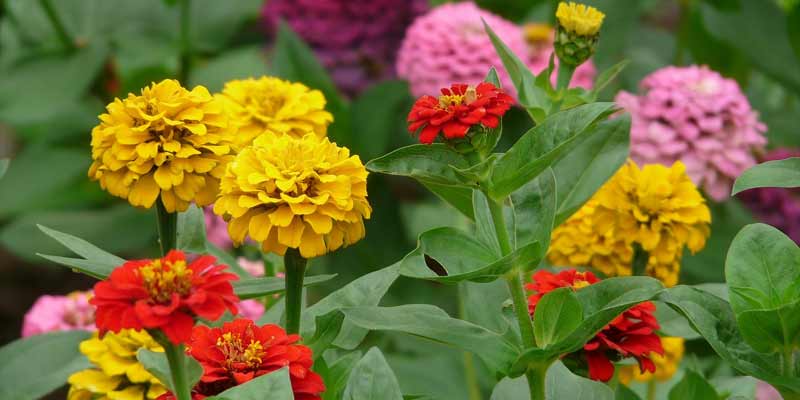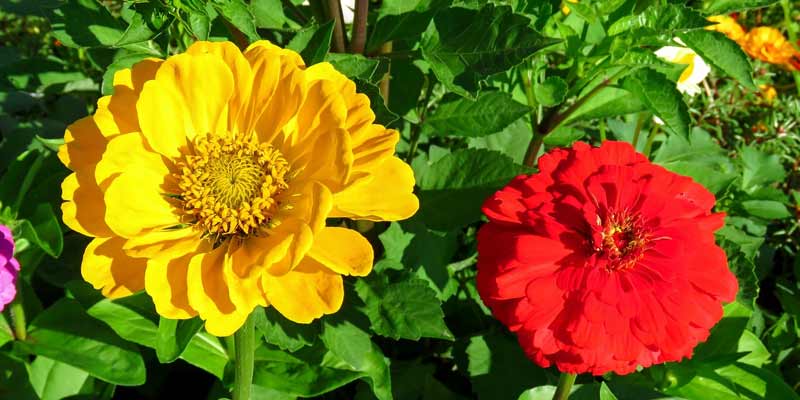Gardeners cherish Zinnias for their vibrant colors and easygoing nature, which can brighten up any landscape. To cultivate flourishing zinnias successfully, one must grasp their sunlight requirements.
This comprehensive guide delves into the nuances of optimal sun exposure needed for thriving zinnia growth and blooming; it offers insightful tips towards this end.
Understanding Zinnias
Native to Mexico and Central America, Zinnia elegans, annual flowering plants are known for their cheerful blooms and versatility. Their popularity in gardens, borders, and containers stems from the wide range of colors they come in; further varying them are an array of shapes as well as sizes.
Whether it be compact dwarf varieties or towering giants, zinnias consistently inject any garden landscape with charm–a vibrant burst that epitomizes beauty intertwined with nature.
Sunlight Requirements
Sunlight, it’s the lifeblood of zinnias, these sun-loving plants thrive in its full, unobstructed embrace. To ensure healthy growth; robust blooms and overall plant vigor are maintained at their peak, adequate exposure to sunlight is not just recommended – but rather an essential requirement.
Thus, a comprehensive understanding of zinnia’s unique relationship with sunlight becomes pivotal for successful cultivation strategies. This knowledge underpins all aspects from seed germination through to final harvest – making it indispensable in any gardener’s repertoire.
Full Sun Exposure
Zinnias thrive in locations that bask under full sun, defined as a minimum of six to eight hours of direct sunlight daily: performance is at its peak with such exposure.
Yet, their growth may reap some advantages from an afternoon respite—particularly during the hottest part of the day—in areas characterized by hot summers or intense sunlight; thus favoring zinnias with partial shade could be beneficial.
Partial Shade Tolerance
Zinnias, although they prefer full sun, exhibit a commendable tolerance for partial shade, a trait particularly beneficial in regions characterized by scorching summers or limited sunlight.
Yet, it is worth noting that extended periods of shade exposure could lead to leggy growth; diminish flowering capacity; and heighten susceptibility to diseases.
3 Factors Influencing Sunlight Requirements
Several factors influence the sunlight requirements of zinnias:
1. Climate
Zinnias flourish in warm, sun-drenched climates; however, in cooler regions or locales boasting abbreviated growing seasons, the importance of full sunlight exposure increases significantly to guarantee not just adequate growth but also blossoming.
2. Soil Moisture and Drainage
Zinnias necessitate well-drained soil; waterlogged earth may induce root rot and other moisture-related problems. Ample sunlight aids in the desiccation of soil, thus diminishing fungal disease hazards while fostering robust root growth.
3. Air Circulation
Ensuring proper air circulation around zinnia plants proves vital in preventing moisture buildup and mitigating the risk of fungal infections, specifically, powdery mildew.
Zinnias thrive best in open, sunny areas; these conditions promote healthy growth by facilitating consistent air movement which significantly wards off diseases.
Optimizing Sunlight Exposure
Consider the following tips to optimize zinnias’ sunlight exposure, ensuring their healthy growth and blooming:
Selecting the Right Location
Choose a sunny spot in your garden or landscape, one that basks under full sun for most of the day: this is your ideal location. However, be cautious and keep away from areas shaded by imposing trees, buildings, or other structures; these will obstruct sunlight – an element crucial to the growth of zinnias.
Morning Sun Preference
Zinnias flourish under the gentle, less intense morning sunlight. By planting them in east-facing locations, they bask in this milder sun and sidestep harsh afternoon heat; thus, a strategy to consider: promote your zinnia.
Provide Afternoon Shade
In regions boasting hot summers or intense afternoon sunlight, zinnias may benefit from a touch of shade during peak heat. Your consideration of planting taller companion plants – or providing temporary structures for shading – will protect these delicate blooms against excessive heat and potential sunburn.
Rotation of Plantings
Consider rotating your zinnia plantings if you have been growing them in the same location year after year; this strategy prevents soil depletion and the buildup of diseases. By transplanting the zinnias to different areas within your garden, an action that guarantees adequate sunlight exposure, you can maintain optimal health and vigor.
Conclusion
Understanding the sunlight requirements of zinnias and strategizing to optimize their exposure is crucial for successful cultivation; it ensures healthy growth, abundant blooms – and overall plant vitality. Thriving zinnia plants, a source of joy and color throughout any garden’s growing season are within reach when these strategies are implemented by knowledgeable gardeners.
Whether in full sun or partial shade: vibrant with charm that endures, zinnias continue to enchant gardeners – making them cherished additions to any landscape.



Leave a Reply